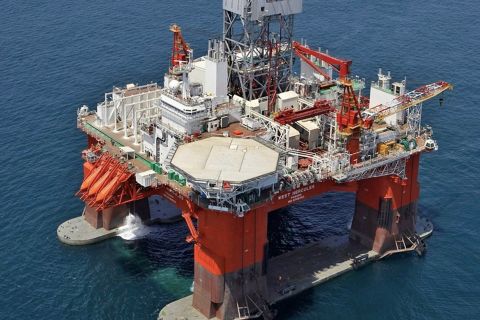
Industry players define a super basin as a basin that has either produced at least 5 billion barrels of oil equivalent or has at least that much in recoverable reserves. (Source: Andrey Priyatkin/Shutterstock.com)
SUGAR LAND, Texas—If the past holds any clues to the future, the start of a new decade could mean a trio of new super basins on the horizon.
Industry players define a super basin as a basin that has either produced at least 5 billion barrels of oil equivalent (Bboe) or has at least that much in recoverable reserves.
“This is a new decade and every decade if you start to look at the numbers, we add three super basins. So, what will be the next three? And I’m not counting unconventionals,” Bob Fryklund, vice president and chief strategist for IHS Markit’s Upstream Energy Group, said during the American Association of Petroleum Geologists’ recently held Global Super Basins Leadership Conference.
Exploration took center stage during the conference as oil and gas companies look to make discoveries and replenish reserves. Exploration spend fell when oil prices started to plummet in 2014, but since then discoveries, improved market conditions and technology have put exploration back in the spotlight.
Which basins rise to super basin status does not necessarily correlate to areas where the most bids are awarded to auctions or where seismic data is being gathered, according to Fryklund. He noted the most blocks in recent years were acquired in the U.S. Gulf of Mexico and the most 2-D and 3-D seismic data were acquired in West Siberia; however, the most resources were discovered offshore Guyana.
Between 10 and 20 billion barrels of resources have been added in the last decade offshore Guyana, where Exxon Mobil Corp. and partners have discovered more than 8 Bboe of estimated recoverable resources; Mauritania/Senegal; and Mozambique’s Rovuma Basin, he said.
The next super basin status candidates could include basins that are undergoing rejuvenation such as the Gulf of Suez/Red Sea Basin area, Brazil’s Campos Basin and Colombia’s Llanos Basin.
“Most of the basins that we look at in the world these days, we actually need to question, even the Permian, the full extent of that basin and how those plays extend,” Fryklund said, later pondering which candidate is best positioned to move forward as a super basin—Brazil and the area around the Equatorial Margin, South Africa/Namibia, deepwater Mexico or the Eastern Mediterranean offshore Lebanon. “It’ll be an interesting year to see how this unfolds.”
Jamie Collard, senior analyst for Westwood Global Energy Group, also pointed to specific prospects, looking at planned tests in frontier basins that could unlock resources. Among these are Total’s Venus well, testing a Cretaceous stratigraphic trap in deepwater offshore Namibia in the Orange Basin; and Bahama Petroleum Co.’s Perseverance #1 exploration well offshore Bahamas—to name a few.
The world’s basins, Collard said, can be broken into three categories: the “known knowns,” or the proven historic super basins like the North Sea and deepwater Gulf of Mexico and the new entries such as Suriname/Guyana, Rovuma and the MSGBC (Mauritania, Senegal, The Gambia, Guinea Bissau and Guinea-Conakry) Basin; the “known unknowns,” which are proven basins that haven’t reached super basin status such as those offshore Peru and South Africa; and the “unknown unknowns,” or the remaining frontier basins.
Frontier exploration activity has mirrored the fall in oil prices in the last 10 years, according to Collard. The number of frontier play wells dropped from more than 50 in 2014 to only 20 in 2017, Westwood data show.
“All in all, over the past 10 years, there’s been 404 frontier play wells drilled in 134 basins by 111 different operators,” Collard said. That came with a drilling spend of about $30 billion. About one-third of those wells were drilled in proven basins, and wells drilled in those proven basins have a higher commercial success rate compared to those drilled in frontier basins, he said.
However, the biggest new plays have come from frontier basins in terms of resource, averaging about 5 million boe and ranging in size from about 500 million barrels up to 15 billion barrels, Collard added.
Getting access, via participating in bid rounds for example, is part of the journey. But, as Fryklund pointed out, “people are not roving all over the world” and “the fiscal terms need to match the risk and reward.” He recalled the late-2019 Brazil back-to-back auctions, including one for presalt blocks, that essentially flopped with only three of nine blocks receiving bids.
“These are some of the largest fields found in the world in recent years, but people question the economics,” he said. “This is part of that fundamental change in what’s happening, … and it’s part of what will happen in the future.”
Looking back over the last three years, he said most of the awards given globally were for blocks in proven basins, many of which are considered mature, like the Gulf of Mexico where more than 2 million barrels of oil is produced per day.
Other areas seeing success include: Siberia with nearly 11 trillion cubic feet of new discoveries, mainly in the Yamal Peninsula area; and the Alaskan North Slope, where Oil Search Ltd. in January said its Mitquq 1 exploration well hit hydrocarbon pay in the Nanushuk reservoir. This list also includes Mexico’s Sureste Basin, the Congo Basin, Saudi Arabia’s Rub al-Khali and Australia’s Perth Basin.
However, “Very few people are playing in that emerging and frontier world,” he said.
Westwood expects about 60 to 70 frontier play tests over the next three years, including 15 to 20 basins to be tested. “It’s very possible that all of the basins I’ve mentioned, none of them could become future super basins, unfortunately,” Collard said.
Recommended Reading
US Drillers Add Oil, Gas Rigs for Second Week in a Row
2024-01-26 - The oil and gas rig count, an early indicator of future output, rose by one to 621 in the week to Jan. 26.
Second Light Oil Discovery in Mopane-1X Well
2024-01-26 - Galp Energia's Avo-2 target in the Mopane-1X well offshore Namibia delivers second significant column of light oil.
E&P Highlights: Jan. 29, 2024
2024-01-29 - Here’s a roundup of the latest E&P headlines, including activity at the Ichthys Field offshore Australia and new contract awards.
Seadrill Awarded $97.5 Million in Drillship Contracts
2024-01-30 - Seadrill will also resume management services for its West Auriga drillship earlier than anticipated.
Oceaneering Won $200MM in Manufactured Products Contracts in Q4 2023
2024-02-05 - The revenues from Oceaneering International’s manufactured products contracts range in value from less than $10 million to greater than $100 million.





